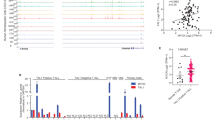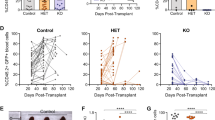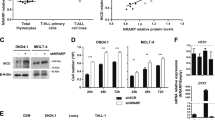Abstract
Aberrant activation of NOTCH1 signaling plays a vital role in the pathogenesis of T-cell acute lymphoblastic leukemia (T-ALL). Yet the molecular events downstream of NOTCH1 that drive T-cell leukemogenesis remain incompletely understood. Starting from genome-wide gene-expression profiling to seek important NOTCH1 transcriptional targets, we identified DEP-domain containing mTOR-interacting protein (DEPTOR), which was previously shown to be important in multiple myeloma but remains functionally unclear in other hematological malignancies. Mechanistically, we demonstrated NOTCH1 directly bound to and activated the human DEPTOR promoter in T-ALL cells. DEPTOR depletion abolished cellular proliferation, attenuated glycolytic metabolism and enhanced cell death, while ectopically expressed DEPTOR significantly promoted cell growth and glycolysis. We further showed that DEPTOR depletion inhibited while its overexpression enhanced AKT activation in T-ALL cells. Importantly, AKT inhibition completely abrogated DEPTOR-mediated cell growth advantages. Moreover, DEPTOR depletion in a human T-ALL xenograft model significantly delayed T-ALL onset and caused a substantial decrease of AKT activation in leukemic blasts. We thus reveal a novel mechanism involved in NOTCH1-driven leukemogenesis, identifying the transcriptional control of DEPTOR and its regulation of AKT as additional key elements of the leukemogenic program activated by NOTCH1.
This is a preview of subscription content, access via your institution
Access options
Subscribe to this journal
Receive 50 print issues and online access
$259.00 per year
only $5.18 per issue
Buy this article
- Purchase on Springer Link
- Instant access to full article PDF
Prices may be subject to local taxes which are calculated during checkout






Similar content being viewed by others
References
Van Vlierberghe P, Ferrando A . The molecular basis of T cell acute lymphoblastic leukemia. J Clin Invest 2012; 122: 3398–3406.
Pui CH, Evans WE . Treatment of acute lymphoblastic leukemia. N Engl J Med 2006; 354: 166–178.
Weng AP, Ferrando AA, Lee W, Morris JPT, Silverman LB, Sanchez-Irizarry C et al. Activating mutations of NOTCH1 in human T cell acute lymphoblastic leukemia. Science 2004; 306: 269–271.
O'Neil J, Grim J, Strack P, Rao S, Tibbitts D, Winter C et al. FBW7 mutations in leukemic cells mediate NOTCH pathway activation and resistance to gamma-secretase inhibitors. J Exp Med 2007; 204: 1813–1824.
Thompson BJ, Buonamici S, Sulis ML, Palomero T, Vilimas T, Basso G et al. The SCFFBW7 ubiquitin ligase complex as a tumor suppressor in T cell leukemia. J Exp Med 2007; 204: 1825–1835.
Paganin M, Ferrando A . Molecular pathogenesis and targeted therapies for NOTCH1-induced T-cell acute lymphoblastic leukemia. Blood Rev 2011; 25: 83–90.
Kopan R, Ilagan MX . The canonical Notch signaling pathway: unfolding the activation mechanism. Cell 2009; 137: 216–233.
Taipale M, Jarosz DF, Lindquist S . HSP90 at the hub of protein homeostasis: emerging mechanistic insights. Nat Rev Mol Cell Biol 2010; 11: 515–528.
Liu H, Chi AW, Arnett KL, Chiang MY, Xu L, Shestova O et al. Notch dimerization is required for leukemogenesis and T-cell development. Genes Dev 2010; 24: 2395–2407.
Weng AP, Millholland JM, Yashiro-Ohtani Y, Arcangeli ML, Lau A, Wai C et al. c-Myc is an important direct target of Notch1 in T-cell acute lymphoblastic leukemia/lymphoma. Genes Dev 2006; 20: 2096–2109.
Connell P, Ballinger CA, Jiang J, Wu Y, Thompson LJ, Hohfeld J et al. The co-chaperone CHIP regulates protein triage decisions mediated by heat-shock proteins. Nat Cell Biol 2001; 3: 93–96.
Dohda T, Maljukova A, Liu L, Heyman M, Grander D, Brodin D et al. Notch signaling induces SKP2 expression and promotes reduction of p27Kip1 in T-cell acute lymphoblastic leukemia cell lines. Exp Cell Res 2007; 313: 3141–3152.
Margolin AA, Palomero T, Sumazin P, Califano A, Ferrando AA, Stolovitzky G . ChIP-on-chip significance analysis reveals large-scale binding and regulation by human transcription factor oncogenes. Proc Natl Acad Sci USA 2009; 106: 244–249.
Medyouf H, Gusscott S, Wang H, Tseng JC, Wai C, Nemirovsky O et al. High-level IGF1R expression is required for leukemia-initiating cell activity in T-ALL and is supported by Notch signaling. J Exp Med 2011; 208: 1809–1822.
Real PJ, Tosello V, Palomero T, Castillo M, Hernando E, de Stanchina E et al. Gamma-secretase inhibitors reverse glucocorticoid resistance in T cell acute lymphoblastic leukemia. Nat Med 2009; 15: 50–58.
Roti G, Carlton A, Ross KN, Markstein M, Pajcini K, Su AH et al. Complementary genomic screens identify SERCA as a therapeutic target in NOTCH1 mutated cancer. Cancer Cell 2013; 23: 390–405.
Schnell SA, Ambesi-Impiombato A, Sanchez-Martin M, Belver L, Xu L, Qin Y et al. Therapeutic targeting of HES1 transcriptional programs in T-ALL. Blood 2015; 125: 2806–2814.
Wang H, Zang C, Taing L, Arnett KL, Wong YJ, Pear WS et al. NOTCH1-RBPJ complexes drive target gene expression through dynamic interactions with superenhancers. Proc Natl Acad Sci USA 2014; 111: 705–710.
Wang H, Zou J, Zhao B, Johannsen E, Ashworth T, Wong H et al. Genome-wide analysis reveals conserved and divergent features of Notch1/RBPJ binding in human and murine T-lymphoblastic leukemia cells. Proc Natl Acad Sci USA 2011; 108: 14908–14913.
Peterson TR, Laplante M, Thoreen CC, Sancak Y, Kang SA, Kuehl WM et al. DEPTOR is an mTOR inhibitor frequently overexpressed in multiple myeloma cells and required for their survival. Cell 2009; 137: 873–886.
Bruneau S, Nakayama H, Woda CB, Flynn EA, Briscoe DM . DEPTOR regulates vascular endothelial cell activation and proinflammatory and angiogenic responses. Blood 2013; 122: 1833–1842.
Laplante M, Horvat S, Festuccia WT, Birsoy K, Prevorsek Z, Efeyan A et al. DEPTOR cell-autonomously promotes adipogenesis, and its expression is associated with obesity. Cell Metab 2012; 16: 202–212.
Meng ZX, Li S, Wang L, Ko HJ, Lee Y, Jung DY et al. Baf60c drives glycolytic metabolism in the muscle and improves systemic glucose homeostasis through Deptor-mediated Akt activation. Nat Med 2013; 19: 640–645.
Zhang H, Chen J, Zeng Z, Que W, Zhou L . Knockdown of DEPTOR induces apoptosis, increases chemosensitivity to doxorubicin and suppresses autophagy in RPMI-8226 human multiple myeloma cells in vitro. Int J Mol Med 2013; 31: 1127–1134.
Zhang HR, Chen JM, Zeng ZY, Que WZ . Knockdown of DEPTOR inhibits cell proliferation and increases chemosensitivity to melphalan in human multiple myeloma RPMI-8226 cells via inhibiting PI3K/AKT activity. J Int Med Res 2013; 41: 584–595.
Proud CG . Dynamic balancing: DEPTOR tips the scales. J Mol Cell Biol 2009; 1: 61–63.
Wang Z, Zhong J, Inuzuka H, Gao D, Shaik S, Sarkar FH et al. An evolving role for DEPTOR in tumor development and progression. Neoplasia 2012; 14: 368–375.
Palomero T, Dominguez M, Ferrando AA . The role of the PTEN/AKT Pathway in NOTCH1-induced leukemia. Cell Cycle 2008; 7: 965–970.
Palomero T, Sulis ML, Cortina M, Real PJ, Barnes K, Ciofani M et al. Mutational loss of PTEN induces resistance to NOTCH1 inhibition in T-cell leukemia. Nat Med 2007; 13: 1203–1210.
Palomero T, Ferrando A . Oncogenic NOTCH1 control of MYC and PI3K: challenges and opportunities for anti-NOTCH1 therapy in T-cell acute lymphoblastic leukemias and lymphomas. Clin Cancer Res 2008; 14: 5314–5317.
Piovan E, Yu J, Tosello V, Herranz D, Ambesi-Impiombato A, Da Silva AC et al. Direct reversal of glucocorticoid resistance by AKT inhibition in acute lymphoblastic leukemia. Cancer Cell 2013; 24: 766–776.
Pear WS, Aster JC, Scott ML, Hasserjian RP, Soffer B, Sklar J et al. Exclusive development of T cell neoplasms in mice transplanted with bone marrow expressing activated Notch alleles. J Exp Med 1996; 183: 2283–2291.
Haferlach T, Kohlmann A, Wieczorek L, Basso G, Kronnie GT, Bene MC et al. Clinical utility of microarray-based gene expression profiling in the diagnosis and subclassification of leukemia: report from the International Microarray Innovations in Leukemia Study Group. J Clin Oncol 2010; 28: 2529–2537.
Khwaja SS, Liu H, Tong C, Jin F, Pear WS, van Deursen J et al. HIV-1 Rev-binding protein accelerates cellular uptake of iron to drive Notch-induced T cell leukemogenesis in mice. J Clin Invest 2010; 120: 2537–2548.
Herranz D, Ambesi-Impiombato A, Palomero T, Schnell SA, Belver L, Wendorff AA et al. A NOTCH1-driven MYC enhancer promotes T cell development, transformation and acute lymphoblastic leukemia. Nat Med 2014; 20: 1130–1137.
Lu B, Sun X, Chen Y, Jin Q, Liang Q, Liu S et al. Novel function of PITH domain-containing 1 as an activator of internal ribosomal entry site to enhance RUNX1 expression and promote megakaryocyte differentiation. Cell Mol Life Sci 2015; 72: 821–832.
Xiao Y, Jiang Z, Li Y, Ye W, Jia B, Zhang M et al. ANGPTL7 regulates the expansion and repopulation of human hematopoietic stem and progenitor cells. Haematologica 2015; 100: 585–594.
Ye W, Jiang Z, Li GX, Xiao Y, Lin S, Lai Y et al. Quantitative evaluation of the immunodeficiency of a mouse strain by tumor engraftments. J Hematol Oncol 2015; 8: 59.
Duan S, Skaar JR, Kuchay S, Toschi A, Kanarek N, Ben-Neriah Y et al. mTOR generates an auto-amplification loop by triggering the betaTrCP- and CK1alpha-dependent degradation of DEPTOR. Mol Cell 2011; 44: 317–324.
Gao D, Inuzuka H, Tan MK, Fukushima H, Locasale JW, Liu P et al. mTOR drives its own activation via SCF(betaTrCP)-dependent degradation of the mTOR inhibitor DEPTOR. Mol Cell 2011; 44: 290–303.
Zhao Y, Xiong X, Sun Y . DEPTOR, an mTOR inhibitor, is a physiological substrate of SCF(betaTrCP) E3 ubiquitin ligase and regulates survival and autophagy. Mol Cell 2011; 44: 304–316.
van Stralen E, van de Wetering M, Agnelli L, Neri A, Clevers HC, Bast BJ . Identification of primary MAFB target genes in multiple myeloma. Exp Hematol 2009; 37: 78–86.
Mendes RD, Sarmento LM, Cante-Barrett K, Zuurbier L, Buijs-Gladdines JG, Povoa V et al. PTEN microdeletions in T-cell acute lymphoblastic leukemia are caused by illegitimate RAG-mediated recombination events. Blood 2014; 124: 567–578.
Ren P, Yue M, Xiao D, Xiu R, Gan L, Liu H et al. ATF4 and N-Myc coordinate glutamine metabolism in MYCN-amplified neuroblastoma cells through ASCT2 activation. J Pathol 2015; 235: 90–100.
Qing G, Yan P, Xiao G . Hsp90 inhibition results in autophagy-mediated proteasome-independent degradation of IkappaB kinase (IKK). Cell Res 2006; 16: 895–901.
Hu Y, Su H, Li X, Guo G, Cheng L, Qin R et al. The NOTCH ligand JAGGED2 promotes pancreatic cancer metastasis independent of NOTCH signaling activation. Mol Cancer Ther 2015; 14: 289–297.
Acknowledgements
We thank Drs Warren Pear (University of Pennsylvania, Philadelphia, PA, US), Hongbing Shu and Zan Huang (Wuhan University, Wuhan, People’s Republic of China), Yi Sun (Zhejiang University, Hangzhou, People's Republic of China) for sharing reagents. This work was supported by grants from the National Natural Science Foundation of China, 81470332 and 81272211 to HL, and 81372205 to GQ and New Investigator Foundation, State Education Ministry of China 20120142120097 to HL.
Author information
Authors and Affiliations
Corresponding authors
Ethics declarations
Competing interests
The authors declare no conflict of interest.
Additional information
Supplementary Information accompanies this paper on the Oncogene website
Supplementary information
Rights and permissions
About this article
Cite this article
Hu, Y., Su, H., Liu, C. et al. DEPTOR is a direct NOTCH1 target that promotes cell proliferation and survival in T-cell leukemia. Oncogene 36, 1038–1047 (2017). https://doi.org/10.1038/onc.2016.275
Received:
Revised:
Accepted:
Published:
Issue Date:
DOI: https://doi.org/10.1038/onc.2016.275
This article is cited by
-
Inhibition of mitochondrial complex I reverses NOTCH1-driven metabolic reprogramming in T-cell acute lymphoblastic leukemia
Nature Communications (2022)
-
Nuclear ErbB2 represses DEPTOR transcription to inhibit autophagy in breast cancer cells
Cell Death & Disease (2021)
-
DEPTOR is a direct p53 target that suppresses cell growth and chemosensitivity
Cell Death & Disease (2020)
-
DNA methylation-based classification reveals difference between pediatric T-cell acute lymphoblastic leukemia and normal thymocytes
Leukemia (2020)
-
SHQ1 regulation of RNA splicing is required for T-lymphoblastic leukemia cell survival
Nature Communications (2018)



